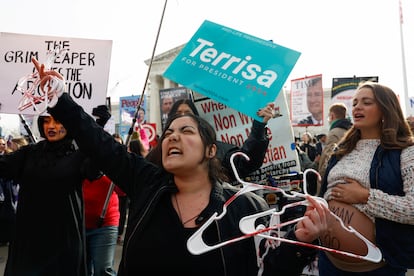Supreme Court seems inclined not to restrict access to abortion pill in US
At the oral arguments in the mifepristone case, a majority of justices appeared skeptical about the legal standing of a Christian doctors’ association to sue the Food and Drug Administration


On Tuesday, the U.S. Supreme Court heard oral arguments in a case that returned the issue of abortion to the high court nearly two years after the justices struck down a half-century of federal protections established in Roe v. Wade. They were debating whether to restrict access to mifepristone, the pill most commonly used in combination with another called misoprostol to terminate pregnancy. After 100 minutes of debate and questions about both sides’ reasons, the nine justices seemed to lean toward not restricting the current level of access to the drug in the United States. The ruling will not be known until the end of the judicial year, at the end of June.
Until then, we can only interpret the judges’ attitudes at Tuesday’s hearing. From that reading, one can conclude that a majority — perhaps all but the two furthest to the right, Samuel Alito and Clarence Thomas — understand that the plaintiffs, an anti-abortion association created specifically to launch this judicial crusade, have not demonstrated that they’ve suffered sufficient harm to have legal standing to sue. The Supreme Court is made up of five men and four women. Three justices identify as liberals and six as conservatives, three of whom were appointed by former President Donald Trump with the express mandate to change the law on abortion in the United States.
The FDA v. Alliance for Hippocratic Medicine (AHM) case stems from a November 2022 lawsuit filed against the Food and Drug Administration in the wake of the controversial Supreme Court ruling that struck down Roe vs. Wade in June of that year, which returned the power to regulate women’s reproductive freedom to the states. AHM chose to start its judicial war in Amarillo, Texas, knowing that Matthew Kacsmaryk, a conservative Christian judge, would handle the case there, and that his decision would later be reviewed by the Fifth Circuit Court of Appeals, which also has a track record favorable to its interests.
The first 15 minutes of the hearing in the solemn Supreme Court building in Washington, outside the doors of which pro- and anti-abortion protesters had gathered hours before the hearing began, were spent discussing whether the Alliance for Hippocratic Medicine has legal standing to sue the FDA, given that they do not prescribe abortion pills as part of their practice. Elizabeth B. Prelogar, an attorney representing the agency, also argued that even if they did, it would be highly unlikely that they would encounter patients experiencing complications from the use of mifepristone; one of the studies provided by the FDA puts the number of such cases at 0.32%. The AHM claims that “tens of thousands of complications” have been reported, but it has not provided any evidence of that.
The plaintiffs’ initial objective was to prohibit total access to the abortion pill, which, according to the latest data from the Guttmacher Institute, along with misoprostol, is involved in 63% of the terminations of pregnancy carried out in the United States, a figure that has grown since the Supreme Court overturned Roe. The first drug stops the production of progesterone and interrupts gestation; the second causes contractions in the patient and causes the expulsion of the fetus.
In Amarillo, Kacsmaryk agreed with them, but the Fifth Circuit appeals court, which has jurisdiction over Texas, Louisiana and Mississippi, bought only part of their argument: the one that blames separate 2016 and 2021 decisions, which expanded access to the abortion pill by allowing its prescription via telemedicine and mail-order purchase, for an alleged increase in problems stemming from its more widespread use. Prelogar said there was no data to support such a cause-and-effect relationship. For her part, Jessica Ellsworth, the lawyer who represented Danco, the pharmaceutical company that markets mifepristone, noted in her argument at the Supreme Court that two studies cited by the plaintiffs to claim that the drug is not safe were recently repudiated and retracted by the scientific journal that had published them.
A shorter time frame
If the Supreme Court were to contradict the signals it issued this Tuesday, which are never conclusive, and find for the plaintiffs, mifepristone could continue to be prescribed, but only in person and with a limit of seven weeks, as opposed to the current 10 weeks, which is the time during which science has shown it to be effective in terminating pregnancy. In practice, the new time limit would amount to a ban, since many women do not know by then whether they are pregnant.

Since the Supreme Court overturned Roe v. Wade, 21 states have banned or severely restricted abortion rights amid a chaotic map of intersecting legislation and court battles. Women in those states have resorted to mifepristone more often than before the ruling, because it saves them long and costly trips to other states to access surgical abortions at clinics that are often overwhelmed by the growing demand of the past two years. Studies show that following the Supreme Court ruling, the number of pregnancy terminations has increased rather than decreased in the United States.
Erin Hawley, an attorney representing AHM and wife of Missouri Republican Senator Josh Hawley, a leading voice of the party’s most conservative faction, complained that the anti-abortion movement in the United States — which won a major victory from the Supreme Court in 2022 after four decades of fighting for it — had been harmed by having to focus its efforts “on explaining the dangers of abortion drugs.” Even Clarence Thomas, perhaps the most ideologically right-wing of the nine justices, challenged that argument.
Another question also emerged during the hearing: would the Supreme Court follow the path of previous rulings that have taken away power from government agencies, as it did in 2023 with the EPA, which is charged with protecting the environment? The idea that they have too much influence is a favorite argument of Republican Party hardliners. Another point of the FDA’s argument is that if the high court agrees with the other side, it will open the floodgates for any drug decision to be challenged on political grounds. After this Tuesday’s hearing, it appears that the justices will not use this case to further that strategy.
This will not be the only time this year that the high court weighs in on the issue of abortion, one of the issues that has done the most to deteriorate the American public’s view of it, which is more unfavorable than ever. In April, they will examine the case Idaho v. United States, in which they must decide the legality of a Midwestern state’s anti-abortion law, one of the strictest in the country. According to its detractors, the law poses a difficult-to-resolve dilemma for doctors and nurses in cases where the mother’s life is in danger if she is forced to continue with the pregnancy. If medical professionals terminate a pregnancy, under the Idaho law they risk losing their license or even ending up in jail. But if they did not do so, they would contravene a federal law that requires hospitals that offer emergency services to intervene if the patient’s health is at risk.
Sign up for our weekly newsletter to get more English-language news coverage from EL PAÍS USA Edition
Tu suscripción se está usando en otro dispositivo
¿Quieres añadir otro usuario a tu suscripción?
Si continúas leyendo en este dispositivo, no se podrá leer en el otro.
FlechaTu suscripción se está usando en otro dispositivo y solo puedes acceder a EL PAÍS desde un dispositivo a la vez.
Si quieres compartir tu cuenta, cambia tu suscripción a la modalidad Premium, así podrás añadir otro usuario. Cada uno accederá con su propia cuenta de email, lo que os permitirá personalizar vuestra experiencia en EL PAÍS.
¿Tienes una suscripción de empresa? Accede aquí para contratar más cuentas.
En el caso de no saber quién está usando tu cuenta, te recomendamos cambiar tu contraseña aquí.
Si decides continuar compartiendo tu cuenta, este mensaje se mostrará en tu dispositivo y en el de la otra persona que está usando tu cuenta de forma indefinida, afectando a tu experiencia de lectura. Puedes consultar aquí los términos y condiciones de la suscripción digital.
More information
Archived In
Últimas noticias
A survivor’s account of the Interoceanic Train accident: ‘We were scared because of the speed on the curve’
The Interoceanic Train, the Mexican alternative to the Panama Canal
What is known about the Interoceanic Train derailment in Oaxaca
Trump turns a Minnesota fraud allegation into ammunition for his MAGA army against Democrats
Most viewed
- Oona Chaplin: ‘I told James Cameron that I was living in a treehouse and starting a permaculture project with a friend’
- Reinhard Genzel, Nobel laureate in physics: ‘One-minute videos will never give you the truth’
- Why the price of coffee has skyrocketed: from Brazilian plantations to specialty coffee houses
- Pablo Escobar’s hippos: A serious environmental problem, 40 years on
- Chevy Chase, the beloved comedian who was a monster off camera: ‘Not everyone hated him, just the people who’ve worked with him’










































